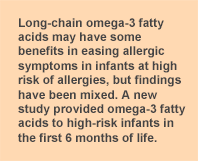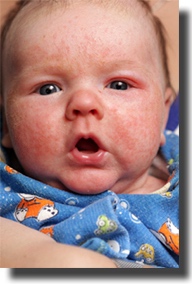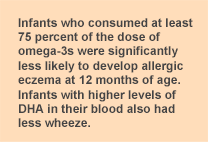
To evaluate whether long-chain omega-3 fatty acids might improve the occurrence or symptoms of allergic disease in infants at high risk of these conditions, investigators have often provided the omega-3s through the mother’s diet. It is generally believed that the earlier an infant is exposed to these fatty acids, the greater the likelihood of benefit. However, findings have been contradictory and inconsistent. We still cannot say with confidence that providing these fatty acids through maternal supplementation in pregnancy will help the offspring. There is enough encouraging evidence of some benefit that researchers continue to pursue studies with omega-3 fatty acids. For one, we know that increased intake of long-chain omega-3s reduces the production of substances that promote inflammation. That may be one reason why the symptoms of allergic disease are less severe in some individuals who were exposed to higher levels of omega-3s in early life. Less attention has been paid to providing omega-3s to high-risk infants shortly after birth. One reason is that such studies have yielded only limited success. But a research team in Australia pursued this strategy in breastfed infants. They developed a novel yet simple approach to giving the infants fish oil—the mother simply squirted the contents of omega-3 capsules

into the infant’s mouth during feeding. For formula-fed infants, the capsule contents were mixed into the formula. Participating families were asked to provide the omega-3s for the first 6 months of the infant’s life. Nearly all infants received some breast milk after birth, even though duration of breastfeeding varied. Infants were evaluated for symptoms of allergic disease and sensitivity reactions to skin prick tests at 6 and 12 months of age. At one year of age, there were no differences in allergic symptoms between the omega-3 supplemented infants and the placebo group. However, among the infants who received more than 75 percent of the intended amount of omega-3s, symptoms of eczema were significantly less. Supporting this observation, infants with higher omega-3s in their blood at 6 months were also less likely to have eczema at 12 months of age. Infants with higher DHA or total omega-3s in their blood also had less wheeze than infants with lower levels. No other allergic symptoms differed between the groups.

As others have observed, the omega-3s did not prevent the development of allergic symptoms, but they were associated with fewer occurrences of eczema and wheeze. A limitation of the study was the fact that only 57% of the omega-3 group actually provided the omega-3 supplement. Thus, for the whole treatment group, the amount of omega-3s provided was substantially less than the study intended. The fact that infants who did receive most of the supplement experienced improved results suggests that the omega-3s were effective in reducing allergic symptoms. Further, the omega-3 infants also had lower levels of some inflammatory substances and increased markers of a more mature immune system. These encouraging findings suggest that infants at high risk of developing allergic diseases may benefit from higher intakes of long-chain omega-3s in early infancy through at least 6 months of age. Even if the mother does not increase her consumption of omega-3s during pregnancy, her child might benefit from early supplementation. Studies with larger numbers of mothers and infants are needed to confirm this possibility.
 To evaluate whether long-chain omega-3 fatty acids might improve the occurrence or symptoms of allergic disease in infants at high risk of these conditions, investigators have often provided the omega-3s through the mother’s diet. It is generally believed that the earlier an infant is exposed to these fatty acids, the greater the likelihood of benefit. However, findings have been contradictory and inconsistent. We still cannot say with confidence that providing these fatty acids through maternal supplementation in pregnancy will help the offspring. There is enough encouraging evidence of some benefit that researchers continue to pursue studies with omega-3 fatty acids. For one, we know that increased intake of long-chain omega-3s reduces the production of substances that promote inflammation. That may be one reason why the symptoms of allergic disease are less severe in some individuals who were exposed to higher levels of omega-3s in early life. Less attention has been paid to providing omega-3s to high-risk infants shortly after birth. One reason is that such studies have yielded only limited success. But a research team in Australia pursued this strategy in breastfed infants. They developed a novel yet simple approach to giving the infants fish oil—the mother simply squirted the contents of omega-3 capsules
To evaluate whether long-chain omega-3 fatty acids might improve the occurrence or symptoms of allergic disease in infants at high risk of these conditions, investigators have often provided the omega-3s through the mother’s diet. It is generally believed that the earlier an infant is exposed to these fatty acids, the greater the likelihood of benefit. However, findings have been contradictory and inconsistent. We still cannot say with confidence that providing these fatty acids through maternal supplementation in pregnancy will help the offspring. There is enough encouraging evidence of some benefit that researchers continue to pursue studies with omega-3 fatty acids. For one, we know that increased intake of long-chain omega-3s reduces the production of substances that promote inflammation. That may be one reason why the symptoms of allergic disease are less severe in some individuals who were exposed to higher levels of omega-3s in early life. Less attention has been paid to providing omega-3s to high-risk infants shortly after birth. One reason is that such studies have yielded only limited success. But a research team in Australia pursued this strategy in breastfed infants. They developed a novel yet simple approach to giving the infants fish oil—the mother simply squirted the contents of omega-3 capsules into the infant’s mouth during feeding. For formula-fed infants, the capsule contents were mixed into the formula. Participating families were asked to provide the omega-3s for the first 6 months of the infant’s life. Nearly all infants received some breast milk after birth, even though duration of breastfeeding varied. Infants were evaluated for symptoms of allergic disease and sensitivity reactions to skin prick tests at 6 and 12 months of age. At one year of age, there were no differences in allergic symptoms between the omega-3 supplemented infants and the placebo group. However, among the infants who received more than 75 percent of the intended amount of omega-3s, symptoms of eczema were significantly less. Supporting this observation, infants with higher omega-3s in their blood at 6 months were also less likely to have eczema at 12 months of age. Infants with higher DHA or total omega-3s in their blood also had less wheeze than infants with lower levels. No other allergic symptoms differed between the groups.
into the infant’s mouth during feeding. For formula-fed infants, the capsule contents were mixed into the formula. Participating families were asked to provide the omega-3s for the first 6 months of the infant’s life. Nearly all infants received some breast milk after birth, even though duration of breastfeeding varied. Infants were evaluated for symptoms of allergic disease and sensitivity reactions to skin prick tests at 6 and 12 months of age. At one year of age, there were no differences in allergic symptoms between the omega-3 supplemented infants and the placebo group. However, among the infants who received more than 75 percent of the intended amount of omega-3s, symptoms of eczema were significantly less. Supporting this observation, infants with higher omega-3s in their blood at 6 months were also less likely to have eczema at 12 months of age. Infants with higher DHA or total omega-3s in their blood also had less wheeze than infants with lower levels. No other allergic symptoms differed between the groups.  As others have observed, the omega-3s did not prevent the development of allergic symptoms, but they were associated with fewer occurrences of eczema and wheeze. A limitation of the study was the fact that only 57% of the omega-3 group actually provided the omega-3 supplement. Thus, for the whole treatment group, the amount of omega-3s provided was substantially less than the study intended. The fact that infants who did receive most of the supplement experienced improved results suggests that the omega-3s were effective in reducing allergic symptoms. Further, the omega-3 infants also had lower levels of some inflammatory substances and increased markers of a more mature immune system. These encouraging findings suggest that infants at high risk of developing allergic diseases may benefit from higher intakes of long-chain omega-3s in early infancy through at least 6 months of age. Even if the mother does not increase her consumption of omega-3s during pregnancy, her child might benefit from early supplementation. Studies with larger numbers of mothers and infants are needed to confirm this possibility.
As others have observed, the omega-3s did not prevent the development of allergic symptoms, but they were associated with fewer occurrences of eczema and wheeze. A limitation of the study was the fact that only 57% of the omega-3 group actually provided the omega-3 supplement. Thus, for the whole treatment group, the amount of omega-3s provided was substantially less than the study intended. The fact that infants who did receive most of the supplement experienced improved results suggests that the omega-3s were effective in reducing allergic symptoms. Further, the omega-3 infants also had lower levels of some inflammatory substances and increased markers of a more mature immune system. These encouraging findings suggest that infants at high risk of developing allergic diseases may benefit from higher intakes of long-chain omega-3s in early infancy through at least 6 months of age. Even if the mother does not increase her consumption of omega-3s during pregnancy, her child might benefit from early supplementation. Studies with larger numbers of mothers and infants are needed to confirm this possibility.

